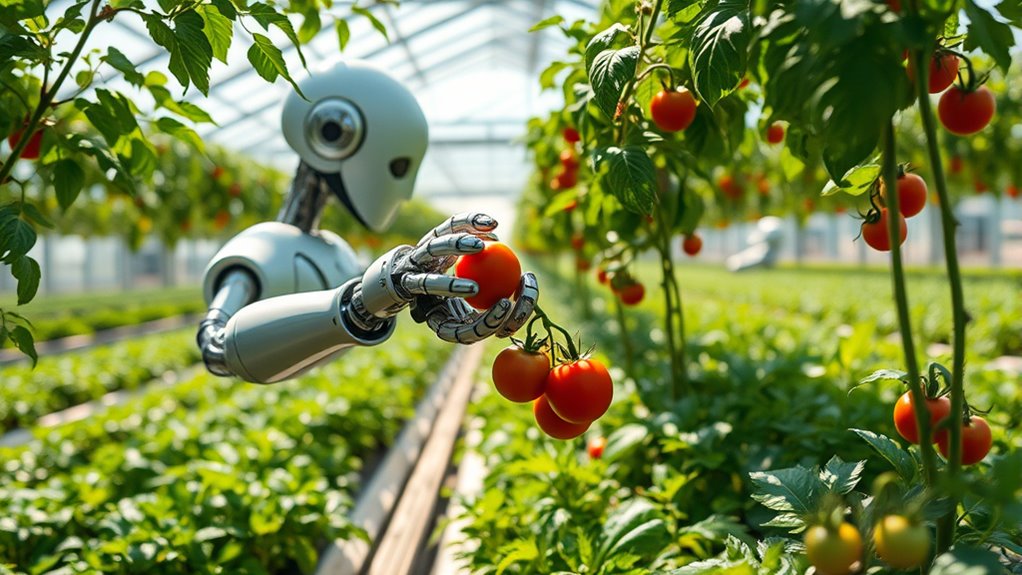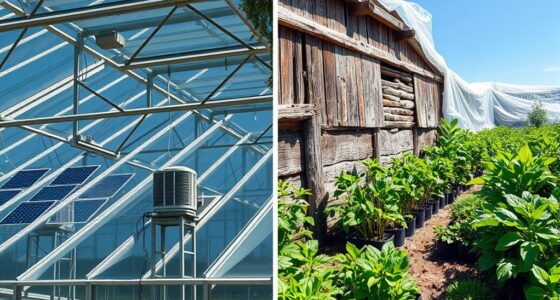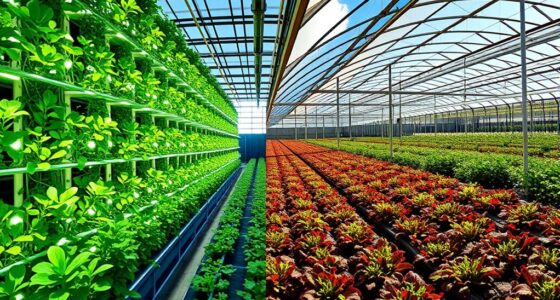Robotic harvesters are now transforming greenhouse farming by using advanced sensors and computer vision to pick ripe vegetables precisely. These robots can operate tirelessly, increasing speed and reducing manual labor. They also perform on-the-spot sorting, ensuring only the best produce reaches consumers. While there are challenges like environmental factors and maintenance, ongoing advancements keep improving their efficiency and adaptability. If you want to discover how these innovative machines are shaping future farming, there’s more to explore below.
Key Takeaways
- Robotic harvesters use sensors and computer vision to identify ripe vegetables accurately.
- Equipped with mechanical arms, they pick and sort produce on the spot, increasing efficiency.
- These robots operate tirelessly, reducing labor costs and physical strain on human workers.
- Continuous calibration and advanced hardware ensure reliable performance in greenhouse environments.
- Future developments aim for smarter, more adaptable robots that seamlessly integrate into existing farms.

As the demand for fresh, locally grown produce increases, farmers are turning to robots to harvest greenhouse vegetables more efficiently. These robots are transforming how we approach harvesting, offering a solution to labor shortages and the need for consistent, high-quality produce. You might wonder how these machines achieve such robotic efficiency. They utilize advanced sensors, computer vision, and precise mechanical arms to identify ripe vegetables, pick them without damaging the plants, and sort them on the spot. This level of automation helps reduce human error and speeds up the harvesting process, ensuring that produce reaches consumers at its peak freshness.
Robotic harvesters use sensors and computer vision to pick and sort vegetables efficiently.
However, integrating robots into greenhouse operations isn’t without its challenges. Automation challenges primarily revolve around adapting these machines to handle the variability in plant size, shape, and ripeness. Unlike traditional harvesting, where human workers can quickly assess and respond to subtle differences, robots need finely tuned algorithms and adaptable hardware to perform reliably across diverse conditions. This means continuous calibration and updates, which can be resource-intensive. Additionally, greenhouse environments are often complex, with varying lighting, humidity, and plant arrangements that can interfere with sensor accuracy. Overcoming these obstacles requires sophisticated programming and robust hardware capable of functioning consistently under different conditions.
You also need to contemplate the initial investment and ongoing maintenance costs. While robotic harvesting promises long-term savings, the upfront expenses can be significant, especially for small to medium-sized farms. Training staff to operate and troubleshoot these systems is another hurdle; despite their automation, robots still require human oversight. This oversight involves routine checks, software updates, and occasional repairs, all of which add to the overall cost and complexity of deploying robotic harvesters. Moreover, ongoing research into sensor technology continues to improve the accuracy and reliability of these machines, promising better performance in the future.
Despite these challenges, the potential benefits of robotic efficiency are compelling. These machines can work tirelessly around the clock, reducing harvest times and increasing yields. They also minimize physical strain on workers and enhance safety by removing the need for manual labor in potentially hazardous conditions. As technology continues to evolve, these robots will become smarter, more adaptable, and easier to integrate into existing greenhouse setups. For you, this means a future where harvesting is faster, more precise, and less dependent on seasonal labor fluctuations. Although automation challenges persist, the ongoing innovations promise a more sustainable and efficient way to bring fresh vegetables from greenhouse to table, revolutionizing the way we think about farming.
Frequently Asked Questions
How Do Robots Identify Ripe Vegetables?
You might wonder how robots identify ripe vegetables. They rely on advanced robot visual recognition and AI ripeness detection to do this efficiently. These robots analyze color, size, and surface texture to determine ripeness accurately. Using cameras and sensors, they process data in real-time, ensuring only ripe vegetables are harvested. This technology streamlines harvesting, reduces waste, and increases productivity in greenhouse farming.
Are Robots Capable of Harvesting Delicate or Irregularly Shaped Produce?
Imagine a robot with gentle robot dexterity, designed to handle produce fragility with care. While some robots excel at harvesting standard vegetables, others are still developing the finesse needed for delicate or irregularly shaped produce. Advances in robotic technology aim to mimic human touch, making it possible to pick fragile items without damage. So, yes—you’re getting closer to robots that can delicately harvest even the most tender and uniquely shaped veggies.
What Safety Measures Prevent Robot Accidents in Greenhouses?
You might wonder how safety measures prevent robot accidents in greenhouses. Manufacturers prioritize robot safety by installing sensors, emergency stop buttons, and safety barriers. These features help detect obstacles, stop operations instantly, and prevent collisions. Regular maintenance and safety protocols guarantee accident prevention and protect both workers and delicate produce. By emphasizing robot safety, greenhouses can operate efficiently while minimizing risks, making automation a secure and effective solution for harvesting.
How Do Robots Adapt to Different Types of Greenhouse Crops?
Imagine a chameleon adapting seamlessly to its surroundings; that’s how robots handle crop diversity. Through robot learning, they analyze each plant’s unique features and adjust their methods accordingly. This adaptability allows them to work efficiently across various greenhouse crops, whether delicate herbs or sturdy vegetables. By constantly learning and refining their skills, robots become versatile harvesters, ensuring your greenhouse stays productive no matter what crop you grow.
What Is the Maintenance Process for These Harvesting Robots?
You’ll need to regularly perform robot calibration to guarantee precise harvesting, adjusting sensors and arms as needed. Keep up with software updates from the manufacturer to improve functionality and fix any bugs. Routine maintenance also includes checking mechanical parts, cleaning sensors, and replacing worn components. By staying on top of calibration and updates, you ensure your harvesting robots operate efficiently, reducing downtime and maximizing crop yield.
Conclusion
So, as robots revolutionize your greenhouse, you’ll witness a wonderful wave of workability and wonder. Their precise, persistent picking promises productivity and perfection, paving the way for a greener, greater future. With automation advancing at an astonishing pace, you’ll embrace the ease and efficiency these engineered experts bring. Ultimately, you’ll find yourself fascinated by this fusion of futuristic finesse and farm-focused functionality, forging a brighter, bountiful future full of fresh, flavorful, and flawlessly harvested veggies.










